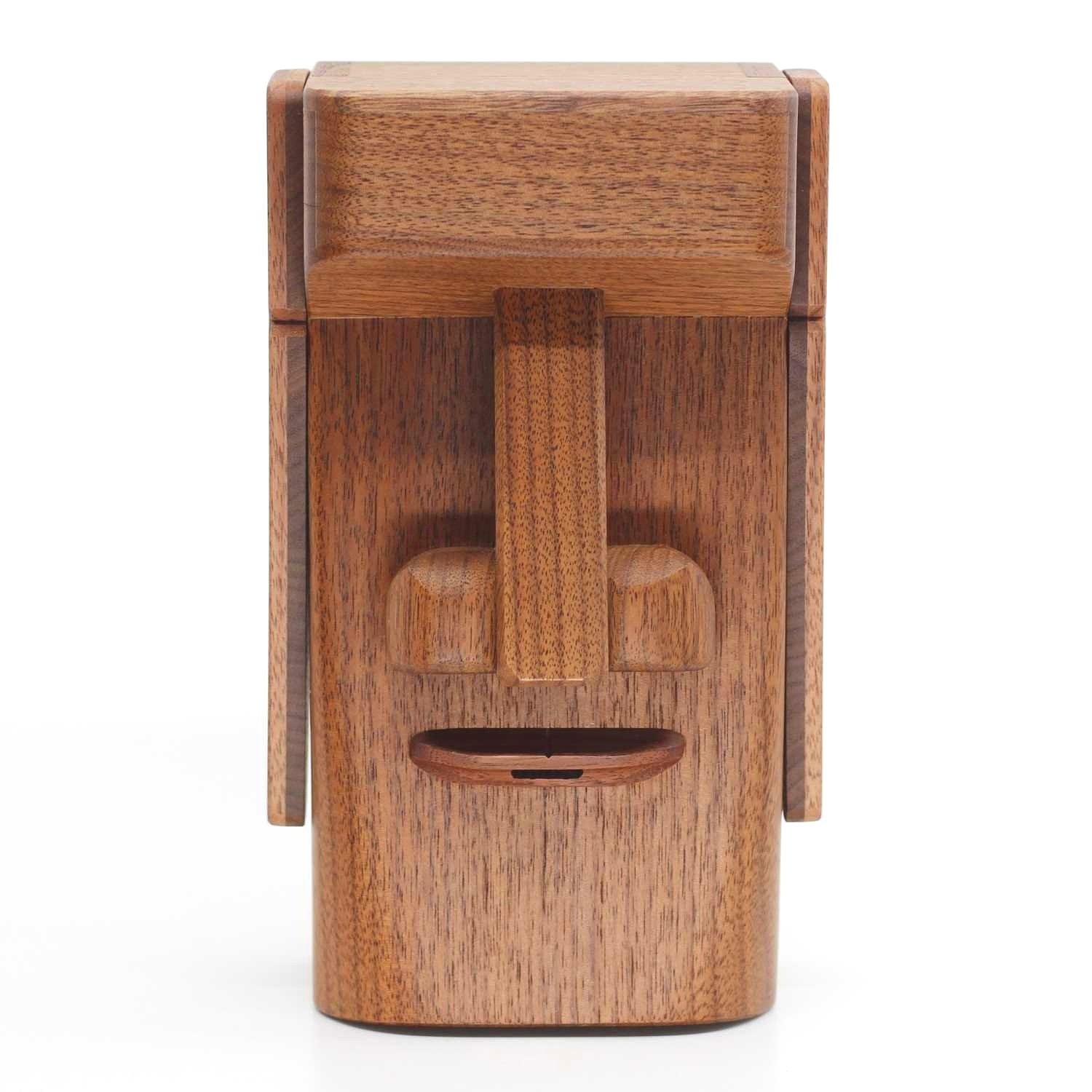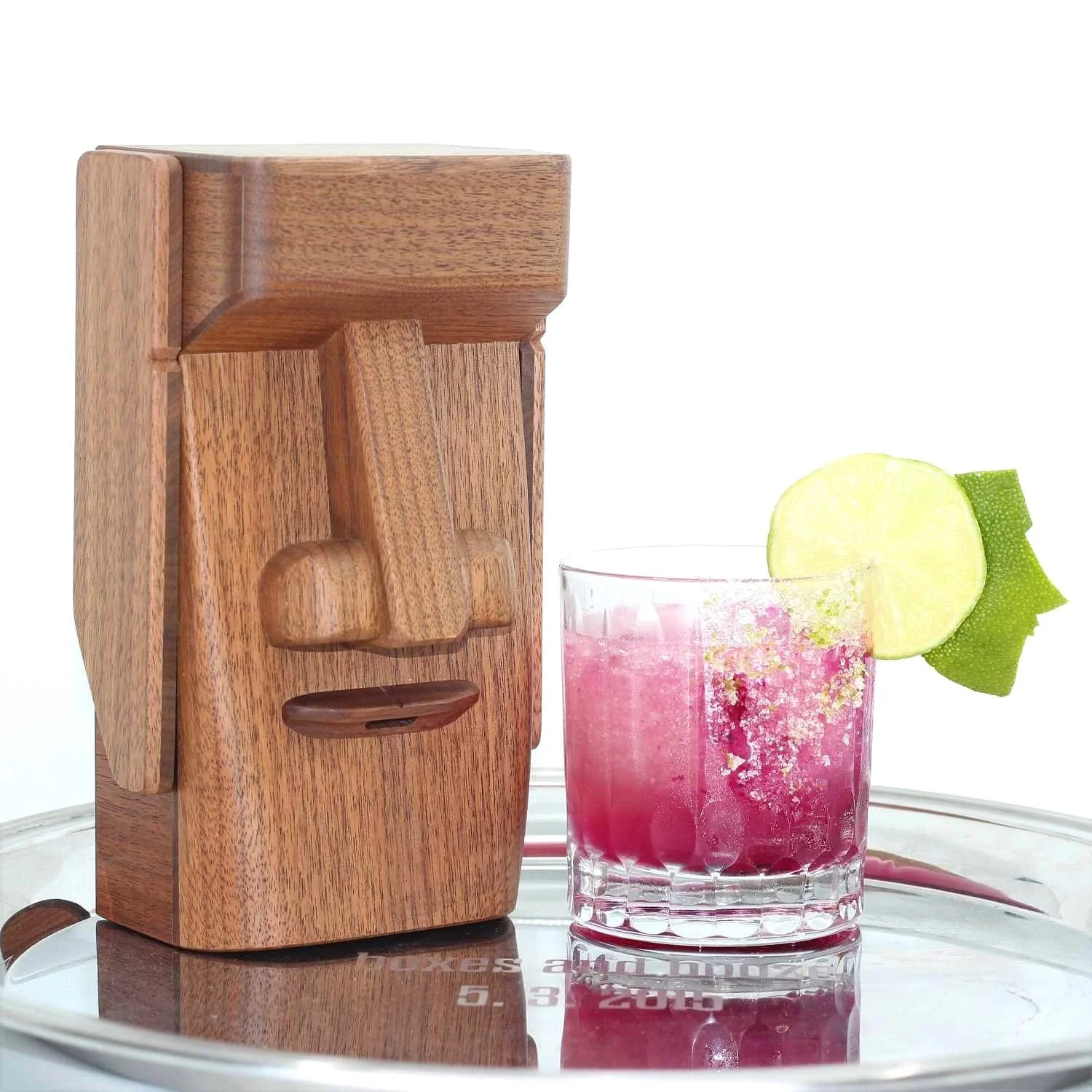Why the Long Face?
Moai
The famous monolithic statues of Easter Island (Rapa Nui) are instantly recognizable for their strikingly simple features that evoke mystery and mysticism. They are the Moai, carved sometime between the years 1250 and 1500 by the indigenous people of the island. The statues were carved in the central island quarry (where many can still be found emerging from the rocks in varying states of completion), and then transported overland to stand sentry all around the island’s perimeter. In the late 18th and early 19th century, many were toppled, but have since been restored. Others appear as only large heads, but buried beneath, deep in the ground, are their bodies. These 80 plus ton statues of volcanic ash have mystified and entertained the whole world with their solemn faces.
Moai by Yasuaki Kikuchi
Japanese Karakuri artist Yasuaki Kikuchi has certainly been entertained by the Moai statues. In fact, the monoliths are particularly special to the Japanese people. At Sun Messe Nichinan, a park near the southern tip of Japan which is dedicated to the sculptures, visitors will find seven sanctioned replicas of actual Moai from Easter Island. Japan is the only country in the world where official replicas are allowed to be made. If you travel in Tokyo to the JR Shibuya Station, you are likely to stop at the large Moai head near the rear entrance, known as the popular meeting spot. The word Moai has another meaning in Japan as well, representing a group of life-long friends who provide social and spiritual support to one another. It is not surprising, after all, that the Moai has become the inspiration for a karakuri box. Kikuchi has taken the idea, and created something truly wonderful, whimsical, challenging, surprising, amusing and fun.
profile pic
Yasuaki Kikuchi explains some of his creation’s story. “I’ve never been to Easter Island. Really wanna go! About three years ago, my nephew said that my face was as long as a Moai, so I wanted to make one someday. At first, the lips were simply a combination of upper and lower lips, but I didn't like it, and I wanted to make it look a little narrower like the real thing. After trial and error, finally I found a facial expression as if smiling. I remember smiling involuntarily too. Also, I thought about making this part of the forehead from solid wood, but since the change in the wood also creates gaps, I ended up with a three-layer laminated structure.” Other details of the Rapanui culture emerge as the Moai is explored. For example, the rongorongo are a system of glyphs discovered on weathered wood boards and other artifacts from Easter Island in the 19th century, excavated near the monoliths, which have never been deciphered. It is unclear if they represent an independent language, genealogic history, or other purpose, and perhaps you must discover that for yourself.
Island secrets
Kukuchi adds, “Moai is an archaeological site that has been loved for a long time here in Japan. From the famous meeting place in front of the station to various miscellaneous goods, many imitations have been made and loved. But in many cases, they had only faces, and the image of them as mysterious ruins with only those humorous and long faces was rooted. Until recently, I always thought so. However, I was surprised to find out later that some of the bodies were buried in the ground with a length suitable for that face. At the same time, my mischief that came to my mind is hidden in this Moai Karakuri box.”
awfully nosy of you
Moai is a wonderful sequential discovery box full of surprises, and might keep you guessing more than once as the secrets of this monolith are revealed. It has Yasuaki’s delightful sense of humor, and you can’t help but laugh as you are forced to “explore” the box in various ways. But like many of his pieces, there is more symbolism at play behind the humor. “I'm sure that the nostrils have become quite large, so I'm sure it's time to take off the mask and breathe through my nose! I think it is a manifestation of that feeling.” We can all use a big breath of fresh air right now. “The world is still chaotic, but I hope you enjoy it with a little laugh in [your] corner.”
Boogie Nights by Vince Ott
My toast to the Moai is in the spirit of fun and a nod to the humor which has been captured so well in this creation. The drink is the playful invention of Vince Ott, from New York’s Thai Diner, his love letter to the kitschy frozen margaritas and colorful drinks of a certain cocktail era. He and his comrades make no excuses about the appeal of an eye popping concoction, and he has certainly pulled no punches with this one. He says that once anyone in the bar orders one, it sells itself because everyone suddenly wants the exciting and fun looking drink.
makin you boogie
In place of orange liqueur, Ott’s margarita has maraschino, which gives it a pop of cherry flavor. He enhances the classic lime juice with hints of exotic makrut lime as well, both as a simple syrup and sweet and salty crust on the glass. The dragon fruit, with it’s kiwi-pear flavor and neon bright burst of color, sends this drink over the top into party town. You’ll have a hard time keeping a long face drinking this, and putting it down. Cheers!
jungle boogie
Boogie Nights by Vince Ott
2 oz blanco tequila
¾ oz maraschino liqueur
¾ oz lime
½ oz makrut lime syrup
1 cup ice
1 tbs red dragon fruit puree
Makrut lime sugar-salt
Green Chartreuse
Combine all but puree in a blender until smooth. Add puree to a favorite glass rimmed in the sugar-salt and pour blended ingredients to layer on top. Spritz the Chartreuse over top and garnish with a pineapple frond and paper umbrella (or lime wheel Moai).
Explore more:







